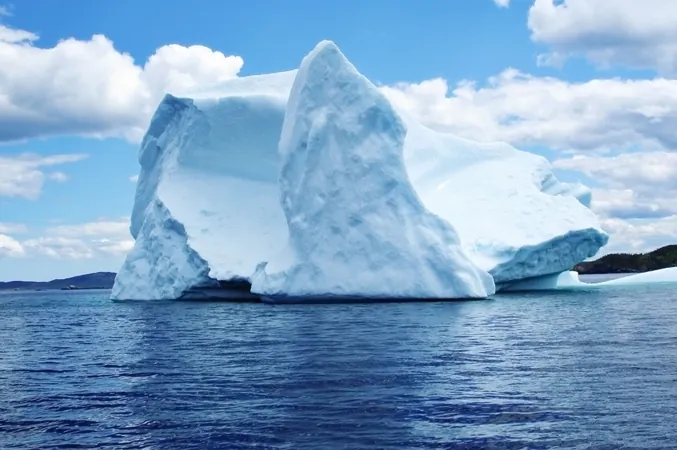
Giant Icebergs Once Roamed Near Britain's Coast, Unveiling Secrets of the Last Ice Age!
2025-04-26
Author: Amelia
When most people envision colossal icebergs—those flat-topped giants resembling city blocks—they usually picture the icy expanses of Antarctica. However, recent groundbreaking research reveals that during the peak of the last ice age, massive icebergs drifted alarmingly close—less than 90 miles—from Britain's east coast.
These gargantuan ice structures, with their deep underbellies, once plowed into the soft marine sediments of the North Sea, leaving behind a breathtaking trail of preserved gouges that have remained intact for nearly 20,000 years.
Iceberg Discovery: A Seafloor Secret Uncovered
Scientists stumbled upon this stunning discovery while sifting through seismic-reflection data originally gathered for oil and gas exploration purposes in the Witch Ground Basin, a shallow trough situated between Scotland and Norway. Instead of the anticipated fossil fuel formations, researchers uncovered peculiar comb-like furrows, stretching kilometers wide—indicative of ancient, flat-topped icebergs carving their way across the seafloor as tides and currents pushed them southward.
Lead researcher James Kirkham from the British Antarctic Survey (BAS) stated, "We’re discussing colossal flat-topped, or ‘tabular,’ icebergs measuring up to several kilometers in width—comparable to the area of medium-sized cities in the UK like Cambridge or Norwich—and potentially a few hundred meters thick!"
Ancient Ice Shelves: A New Perspective on Britain’s Past
These enormous icebergs, which today calve from Antarctic ice shelves, suggest that in ancient times, large ice shelves must have bordered the British and Irish Ice Sheet. This finding transforms our understanding of the region during the Last Glacial Maximum, a time when ice enveloped much of the British Isles, beginning to retreat as temperatures rose between 20,000 and 18,000 years ago.
Understanding these ice shelves is crucial, as they serve to stabilize their parent ice sheets, preventing inland glaciers from flowing too rapidly—a significant factor in rising global sea levels.
The Great Iceberg Shift: A Clue to Ice Loss Dynamics
The seismic data not only captures the era of these gigantic icebergs but also offers insight into their eventual disappearance. Co-author Kelly Hogan of BAS explained, "Around 18,000 years ago, we noticed a dramatic shift in the recorded plough marks, indicating a transition from massive tabular icebergs to a proliferation of smaller icebergs—an indication of ice shelf disintegration." This pattern mirrors events observed in 2002 when the Larsen B Ice Shelf in Antarctica collapsed.
What Triggered This Ice Collapse?
An intriguing question arises: did the ancient breakup of British ice shelves accelerate the retreat of glaciers, or was it simply a byproduct of already increasing ice loss? More precise dating of seafloor deposits could hold the key to unraveling this mystery.
Warning Signs for Our Warming Future
With Greenland and parts of West Antarctica currently shedding ice at unprecedented rates, understanding how ancient ice shelves collapsed and how quickly nearby glaciers responded holds vital implications for predicting future sea-level rise. Rob Larter, a co-author from BAS, noted that observing similar transitions in Antarctica today could signal imminent mass loss.
For now, the hidden marks beneath the North Sea’s sediments stand as silent heralds of a long-gone icy epoch, a time when Britain’s horizon was guarded by icebergs the size of cities—revealing insights that are crucial for addressing future coastal challenges.
This captivating study has been published in the journal Nature Communications, presenting a striking reflection on our planet’s climatic history.









 Brasil (PT)
Brasil (PT)
 Canada (EN)
Canada (EN)
 Chile (ES)
Chile (ES)
 Česko (CS)
Česko (CS)
 대한민국 (KO)
대한민국 (KO)
 España (ES)
España (ES)
 France (FR)
France (FR)
 Hong Kong (EN)
Hong Kong (EN)
 Italia (IT)
Italia (IT)
 日本 (JA)
日本 (JA)
 Magyarország (HU)
Magyarország (HU)
 Norge (NO)
Norge (NO)
 Polska (PL)
Polska (PL)
 Schweiz (DE)
Schweiz (DE)
 Singapore (EN)
Singapore (EN)
 Sverige (SV)
Sverige (SV)
 Suomi (FI)
Suomi (FI)
 Türkiye (TR)
Türkiye (TR)
 الإمارات العربية المتحدة (AR)
الإمارات العربية المتحدة (AR)